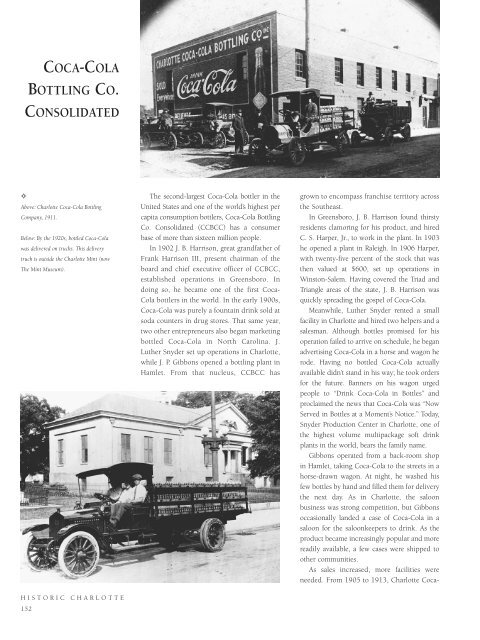Historic Charlotte
An illustrated history of the City of Charlotte and the Mecklenburg County area, paired with the histories of companies, families and organizations that make the region great.
An illustrated history of the City of Charlotte and the Mecklenburg County area, paired with the histories of companies, families and organizations that make the region great.
You also want an ePaper? Increase the reach of your titles
YUMPU automatically turns print PDFs into web optimized ePapers that Google loves.
COCA-COLA<br />
BOTTLING CO.<br />
CONSOLIDATED<br />
✧<br />
Above: <strong>Charlotte</strong> Coca-Cola Bottling<br />
Company, 1911.<br />
Below: By the 1920s, bottled Coca-Cola<br />
was delivered on trucks. This delivery<br />
truck is outside the <strong>Charlotte</strong> Mint (now<br />
The Mint Museum).<br />
HISTORIC CHARLOTTE<br />
152<br />
The second-largest Coca-Cola bottler in the<br />
United States and one of the world’s highest per<br />
capita consumption bottlers, Coca-Cola Bottling<br />
Co. Consolidated (CCBCC) has a consumer<br />
base of more than sixteen million people.<br />
In 1902 J. B. Harrison, great grandfather of<br />
Frank Harrison III, present chairman of the<br />
board and chief executive officer of CCBCC,<br />
established operations in Greensboro. In<br />
doing so, he became one of the first Coca-<br />
Cola bottlers in the world. In the early 1900s,<br />
Coca-Cola was purely a fountain drink sold at<br />
soda counters in drug stores. That same year,<br />
two other entrepreneurs also began marketing<br />
bottled Coca-Cola in North Carolina. J.<br />
Luther Snyder set up operations in <strong>Charlotte</strong>,<br />
while J. P. Gibbons opened a bottling plant in<br />
Hamlet. From that nucleus, CCBCC has<br />
grown to encompass franchise territory across<br />
the Southeast.<br />
In Greensboro, J. B. Harrison found thirsty<br />
residents clamoring for his product, and hired<br />
C. S. Harper, Jr., to work in the plant. In 1903<br />
he opened a plant in Raleigh. In 1906 Harper,<br />
with twenty-five percent of the stock that was<br />
then valued at $600, set up operations in<br />
Winston-Salem. Having covered the Triad and<br />
Triangle areas of the state, J. B. Harrison was<br />
quickly spreading the gospel of Coca-Cola.<br />
Meanwhile, Luther Snyder rented a small<br />
facility in <strong>Charlotte</strong> and hired two helpers and a<br />
salesman. Although bottles promised for his<br />
operation failed to arrive on schedule, he began<br />
advertising Coca-Cola in a horse and wagon he<br />
rode. Having no bottled Coca-Cola actually<br />
available didn’t stand in his way; he took orders<br />
for the future. Banners on his wagon urged<br />
people to “Drink Coca-Cola in Bottles” and<br />
proclaimed the news that Coca-Cola was “Now<br />
Served in Bottles at a Moment’s Notice.” Today,<br />
Snyder Production Center in <strong>Charlotte</strong>, one of<br />
the highest volume multipackage soft drink<br />
plants in the world, bears the family name.<br />
Gibbons operated from a back-room shop<br />
in Hamlet, taking Coca-Cola to the streets in a<br />
horse-drawn wagon. At night, he washed his<br />
few bottles by hand and filled them for delivery<br />
the next day. As in <strong>Charlotte</strong>, the saloon<br />
business was strong competition, but Gibbons<br />
occasionally landed a case of Coca-Cola in a<br />
saloon for the saloonkeepers to drink. As the<br />
product became increasingly popular and more<br />
readily available, a few cases were shipped to<br />
other communities.<br />
As sales increased, more facilities were<br />
needed. From 1905 to 1913, <strong>Charlotte</strong> Coca-
















